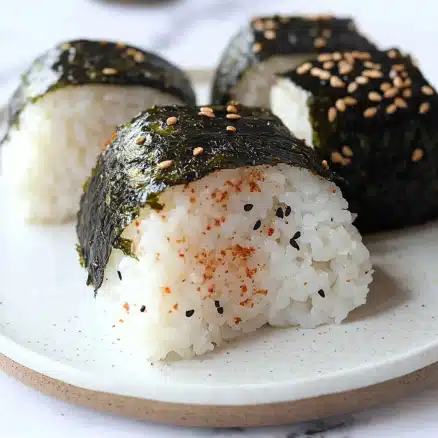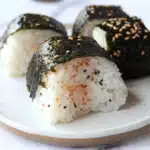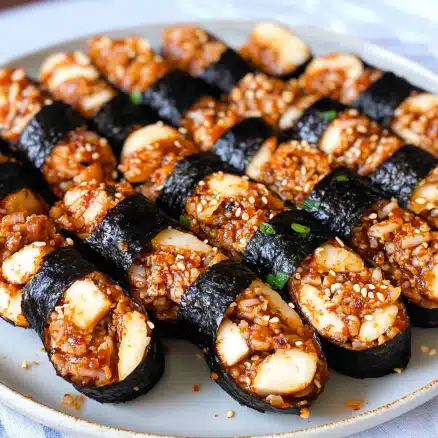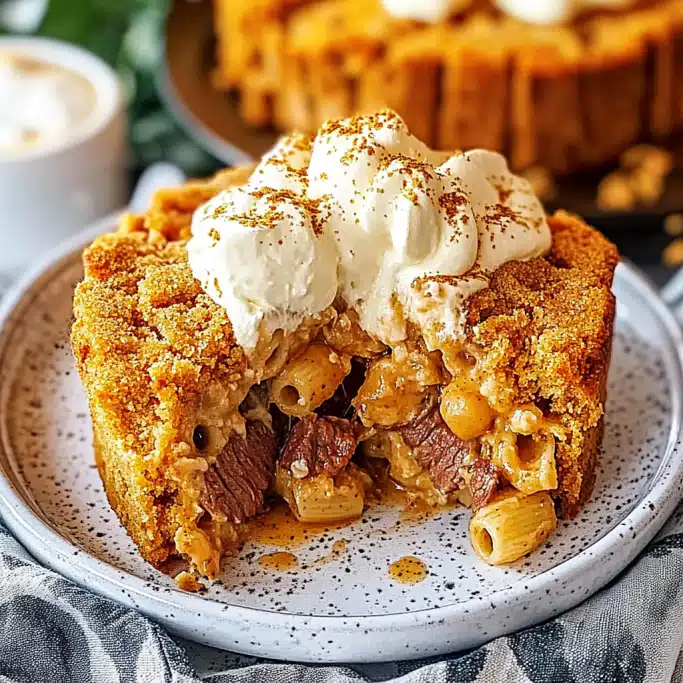Classic Japanese Rice Balls (Onigiri)

Onigiri, or Japanese rice balls, are one of the most iconic and beloved foods in Japan. Found everywhere from convenience stores to lunchboxes, they’re simple to make yet endlessly versatile. At their core, onigiri are balls or triangles of rice shaped by hand and often wrapped in a strip of seaweed (nori). What makes them special is the variety of fillings — from salty pickled plums to savory tuna mayo — tucked inside the soft, seasoned rice.
More than just a snack, onigiri is a cultural staple. They’re portable, satisfying, and a symbol of comfort food in Japanese cuisine. Whether you enjoy them as part of a lunch, pack them for a picnic, or prepare them for your family’s bento boxes, onigiri are the perfect example of how simple ingredients can create something delicious and meaningful.
Ingredients You’ll Need
-
2 cups cooked sushi rice (short-grain rice works best)
-
1 tsp salt
-
2 sheets nori (seaweed), cut into strips
-
1 tbsp sesame seeds (optional)
-
Filling options: tuna mixed with mayonnaise, pickled plum (umeboshi), grilled salmon flakes, or teriyaki chicken
Step-by-Step Instructions
-
Cook the rice – Prepare sushi rice according to package instructions, making sure it’s slightly sticky but not mushy. Allow it to cool just enough so it’s warm and manageable by hand.
-
Season your hands – Wet your hands lightly with water and rub a pinch of salt into them. This keeps the rice from sticking and adds flavor.
-
Shape the rice – Take a handful of rice and press it into a ball or a triangular shape.
-
Add the filling – Press a small indentation into the center, place about 1 teaspoon of filling, then cover with a little more rice, shaping it firmly.
-
Wrap with nori – Place a strip of nori on the bottom or around the rice ball. This makes it easier to hold and adds flavor.
-
Finish with garnish – Sprinkle with sesame seeds or finely chopped herbs if desired.
Flavor Notes & Variations
Onigiri can be filled with almost anything savory. Traditional Japanese fillings include salted cod roe, bonito flakes with soy sauce, and miso paste. For a modern twist, try avocado, kimchi, or even cheese. You can also season the rice itself with furikake (a Japanese rice seasoning blend) to add an extra layer of flavor.
Serving Suggestions
Onigiri are perfect for packed lunches, road trips, or snacks on the go. They pair beautifully with miso soup, pickled vegetables, or a simple salad. For a party platter, prepare different fillings and shapes, then arrange them on a tray for a colorful and fun presentation.
Frequently Asked Questions
1. What type of rice should I use for onigiri?
Short-grain Japanese rice or sushi rice is best. It has the right stickiness to hold its shape.
2. Can I use leftover rice?
Freshly cooked rice works best, but you can use leftover rice if it’s gently reheated and softened with a little water.
3. How do I stop the rice from sticking to my hands?
Keep your hands damp and lightly salted. This helps with shaping and adds a subtle seasoning.
4. How long can onigiri be stored?
Onigiri are best eaten fresh but can be stored in the refrigerator for up to 2 days. Wrap tightly in plastic wrap to keep them moist.
5. Can onigiri be frozen?
Yes, you can freeze them without the nori. Wrap them well, then reheat in the microwave before adding fresh nori.
6. Do I have to use nori?
No, nori is optional. You can serve them plain or roll them in sesame seeds or finely chopped herbs instead.
7. Can I make onigiri vegan?
Absolutely. Try fillings like sautéed mushrooms, pickled vegetables, miso paste, or avocado.
8. Why are some onigiri triangular while others are round?
It’s simply tradition and preference. Triangular shapes are common in convenience stores, while homemade ones are often round or oval.
Conclusion
Classic Japanese Rice Balls, or Onigiri, are the perfect combination of simplicity and flavor. They’re customizable, fun to make, and deeply comforting — a food that feels like home in Japanese culture. Whether you fill them with traditional umeboshi, savory salmon, or a modern twist like tuna mayo, they’re guaranteed to satisfy. Easy to pack, easy to eat, and endlessly versatile, onigiri is a recipe that deserves a spot in every kitchen. Once you try making them, you’ll understand why they’re such a timeless favorite in Japan and beyond.
PrintClassic Japanese Rice Balls (Onigiri)
Classic Japanese Rice Balls, or Onigiri, are a popular and portable Japanese snack made from seasoned rice formed into triangular or oval shapes, often filled with savory ingredients and wrapped with nori (seaweed).
- Prep Time: 10 minutes
- Cook Time: 25 minutes
- Total Time: 35 minutes
- Yield: 6 rice balls 1x
- Category: Snack
- Method: Shaping
- Cuisine: Japanese
- Diet: Halal
Ingredients
- 2 cups Japanese short-grain rice
- 2 1/4 cups water
- 1/2 tsp salt (for seasoning rice)
- 1 sheet nori (seaweed), cut into strips
- Filling of choice (e.g., salted salmon, pickled plum, tuna mayo, kombu, etc.)
- Salt, for hands (to prevent sticking and season the rice)
Instructions
- Rinse the rice under cold water until the water runs clear. Drain well.
- Place the rice and water in a rice cooker or pot. Cook according to rice cooker instructions or bring to a boil, then reduce to low, cover, and simmer for 15 minutes. Let rest covered for 10 minutes.
- Once cooked, fluff the rice and season with 1/2 tsp salt. Let it cool slightly until warm but not hot to the touch.
- Wet your hands with water and rub a little salt on them to prevent sticking.
- Take a handful of warm rice, flatten it slightly, place a small amount of filling in the center, and fold the rice around the filling.
- Shape into a triangle or oval, pressing gently but firmly.
- Wrap with a strip of nori if desired, and repeat with remaining rice and filling.
- Serve immediately or wrap in plastic wrap for later.
Notes
- Keep your hands moist to prevent rice from sticking during shaping.
- Use Japanese short-grain rice for best results—other types won’t hold shape as well.
- Onigiri can be stored in the fridge but are best eaten fresh or at room temperature.
- Fillings should be relatively dry and flavorful to balance the rice.
Nutrition
- Serving Size: 1 rice ball
- Calories: 180
- Sugar: 0g
- Sodium: 150mg
- Fat: 1g
- Saturated Fat: 0g
- Unsaturated Fat: 0.5g
- Trans Fat: 0g
- Carbohydrates: 38g
- Fiber: 1g
- Protein: 3g
- Cholesterol: 0mg
Keywords: onigiri, Japanese rice balls, rice snack, bento food, easy onigiri, traditional Japanese food







